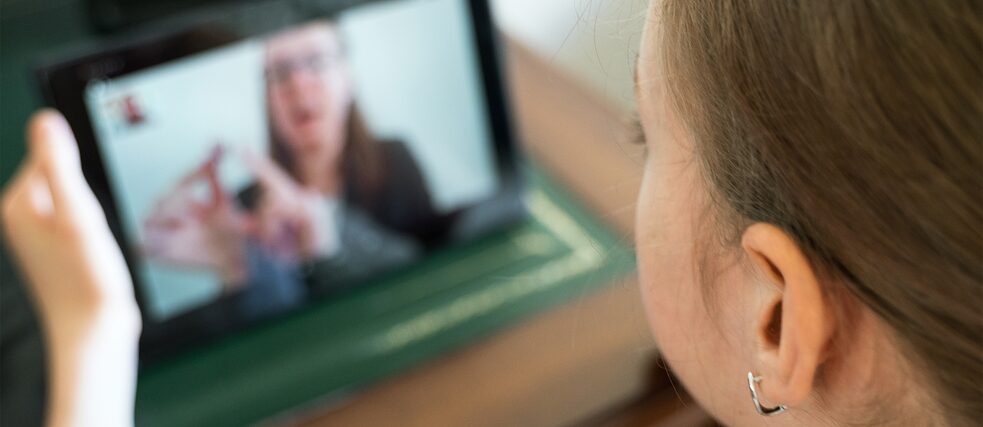New contexts of language teaching
Digital Deterritorialization: Where are German classes being held today?

The World Wide Web seems to be the new classroom of the digital age. But physical real-life spaces still serve an important function even in online German classes. Here are some thoughts on the concept of deterritorialization and its significance in foreign language teaching.
By Janna Degener-Storr
Taken literally, deterritorialization basically means a change of area or removal from any specific location. The term was coined half a century ago by the French philosopher Gilles Deleuze and psychoanalyst Félix Guattari. Social scientists have used the term to describe globalization and migration flows, among other things. At a time in which people all over the world are communicating digitally due to Covid, this phenomenon is perhaps more topical than ever – including in education and, specifically, teaching German. “Online or hybrid teaching raises the question of cultural situatedness: Does it really matter at all where a German class is held?” asks Matthias Jung, director of the Institute for International Communication (IIK) in Düsseldorf and Berlin and president of the Fachverband Deutsch als Fremd- und Zweitsprache (FaDaF, Association of Teachers of German as a Foreign or Second Language). “Can a teacher who, for example, has been living for decades on the other side of the globe still open a window on Germany for their learners? And I don’t mean a window in Windows, needless to say!” And Annegret Middeke, a cultural scientist and managing director of the FaDaF, has applied the concept of deterritorialization to the digitalization debate, asking, “How can cultural mediation work in the virtual realm?”
 The not-so new normal? | © Colourbox
One thing’s for sure: if location no longer makes any difference, teachers based in Germany are going to be competing on the global market with colleagues who can offer online instruction for much lower fees. Learners taking live lessons online don’t necessarily know where the teacher is. Which has some advantages. Among other things, because teachers have a wide range of options available when it comes to integrating their real-life surroundings into a live online class or situating it in some other specific place, which may even be made up. “Some teachers working from home put their whole private lives on display,” observes Matthias Jung, “giving learners a peek into their own homes, showing them how they prepare meals in the kitchen and even letting them chat with their kids.” Teachers can also work recorded contributions by “visiting experts” into their subject-specific courses, for example, or send learners off to interesting places to capture images and sounds on their smartphones and share them with the group.
The not-so new normal? | © Colourbox
One thing’s for sure: if location no longer makes any difference, teachers based in Germany are going to be competing on the global market with colleagues who can offer online instruction for much lower fees. Learners taking live lessons online don’t necessarily know where the teacher is. Which has some advantages. Among other things, because teachers have a wide range of options available when it comes to integrating their real-life surroundings into a live online class or situating it in some other specific place, which may even be made up. “Some teachers working from home put their whole private lives on display,” observes Matthias Jung, “giving learners a peek into their own homes, showing them how they prepare meals in the kitchen and even letting them chat with their kids.” Teachers can also work recorded contributions by “visiting experts” into their subject-specific courses, for example, or send learners off to interesting places to capture images and sounds on their smartphones and share them with the group.
From concern to curiosity: teachers and learners weigh in
A FaDaF poll of German learners and experts shows what different emotions and thoughts the term “digital deterritorialization” can evoke: Some feel it’s a threat – among other things, because many people in the real world have little or no access to the digital world for technical reasons. Others see it as an opportunity for greater educational equity. Some feel the need to create a sense of closeness in the virtual realm, and some add that such virtual contact can arouse curiosity about eventually meeting up face to face. But online learning raises a great many questions: Do virtual worlds hold realms and boundaries beyond language or is the whole world our classroom today? What are the challenges learners and teachers have to grapple with to be in several places at the same time in virtual space? What rules of coexistence apply there and how are they negotiated? What digital divides do we need to overcome? What might hybrid German learning involve in future? The not-so new normal? | © Colourbox
One thing’s for sure: if location no longer makes any difference, teachers based in Germany are going to be competing on the global market with colleagues who can offer online instruction for much lower fees. Learners taking live lessons online don’t necessarily know where the teacher is. Which has some advantages. Among other things, because teachers have a wide range of options available when it comes to integrating their real-life surroundings into a live online class or situating it in some other specific place, which may even be made up. “Some teachers working from home put their whole private lives on display,” observes Matthias Jung, “giving learners a peek into their own homes, showing them how they prepare meals in the kitchen and even letting them chat with their kids.” Teachers can also work recorded contributions by “visiting experts” into their subject-specific courses, for example, or send learners off to interesting places to capture images and sounds on their smartphones and share them with the group.
The not-so new normal? | © Colourbox
One thing’s for sure: if location no longer makes any difference, teachers based in Germany are going to be competing on the global market with colleagues who can offer online instruction for much lower fees. Learners taking live lessons online don’t necessarily know where the teacher is. Which has some advantages. Among other things, because teachers have a wide range of options available when it comes to integrating their real-life surroundings into a live online class or situating it in some other specific place, which may even be made up. “Some teachers working from home put their whole private lives on display,” observes Matthias Jung, “giving learners a peek into their own homes, showing them how they prepare meals in the kitchen and even letting them chat with their kids.” Teachers can also work recorded contributions by “visiting experts” into their subject-specific courses, for example, or send learners off to interesting places to capture images and sounds on their smartphones and share them with the group.